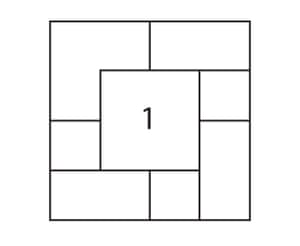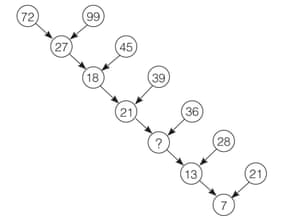Use your wits! Can you solve these fiendishly difficult puzzles?

Isn’t it time we learned to reconnect with the idea of problem-solving for fun? After all, argues Alex Bellos, the best puzzles are pieces of poetry. In an exclusive extract from his new book, he selects some of his favourites.

For those of us whose school memories include struggling with long division and quadratic equations, it may be surprising to learn that there was a time when almost all mathematics was recreational.
In the medieval world, for example, the role of maths was mostly as an intellectual diversion. (Apart from its use for technical, real-life tasks like measuring land area or calculating tax.) When, in 799, the British scholar Alcuin of York sent a letter containing 50 or so maths problems to Charlemagne, he did so not to infuriate the king but to amuse him.
In ancient times, too, many arithmetical problems were designed to entertain. Indeed, for the Greeks, a principle motivation for studying geometry was intellectual stimulation and discovery, with no concern for practical applications.
Maths got serious during the scientific revolution. Blame Isaac Newton. The discovery of his laws of motion and gravitation and the infinitesimal calculus, which provided the tools for dealing with these new ideas created new, difficult jobs for mathematicians to do, like finding the equations that describe as much of the world as possible.
The consequences are still felt today. Maths has mostly lost its reputation as a vehicle for playfulness and diversion. (When a piece of mathematics becomes successful, as in the case of sudoku, people make the excuse that this isnt maths, as if it stops being so merely by being popular.) And this is a shame, because we are depriving ourselves of a lot of fun.
Maths and logic puzzles are pleasurable and life-affirming because they force us to use our wits. A good puzzle is also never too hard to solve, thus presenting us with an achievable goal, supremely gratifying when it comes. In a puzzle we are proving to ourselves that we can do something we doubted we could. Deductive reasoning in simple logical steps is comforting, especially when real life is so illogical.
Beginning with Alcuin, Britain has produced many illustrious puzzlesmiths. Alcuin is notable as the first writer to introduce humour into mathematical problems, and his teasers have stood the test of time. Few adults can be unaware of his most famous riddle, about a traveller trying to cross a river with a wolf, a goat and some cabbages, which was once even featured in an episode of The Simpsons. I like the other types of puzzle he introduced too, such as questions about strange family relationships.
In the 19th century Lewis Carroll popularised the fun to be had with logic in Alices Adventures in Wonderland and Through the Looking-Glass. But Britains greatest ever puzzle inventor was Henry Ernest Dudeney, whose puzzles appeared for decades in British newspapers and magazines. In April 1930, the month Dudeney died, one of his most influential puzzles appeared in Strand Magazine the literary journal that published Conan Doyles first Sherlock Holmes stories. Smith, Jones and Robinson inspired a whole new genre of inferential logic puzzles in which the solver must deduce conclusions from a list of whimsical statements. These puzzles invite you to become a detective. On first reading it looks like there is far too little information to find the answer. But slowly you will piece together the clues.
Even when maths got serious in the late 17th century, however, it did not totally lose its element of play. As well as finding out the equations for commonplace phenomena like the vibration of string, mathematicians also used Newtons new tools to investigate unusual and bizarre curves. In fact, many great discoveries have come from mathematicians trying to understand simple puzzles and games. Most obviously, perhaps, the field of probability and therefore all of statistics was the result of Blaise Pascal and Pierre de Fermats correspondence about gambling games.
Not only have great mathematicians used simple brainteasers to inspire new research, but they have also devised many of their own puzzles. Edouard Lucas, who in the 19th century made important advances in our understanding of prime numbers, wrote a book of puzzles for the general reader and also invented a few classic problems.
Despite the current poor image of maths, the ubiquity of sudoku attests that maths puzzles do remain a popular pastime for many. I discovered quite how much a good puzzle can go viral when I posted a puzzle from a Singapore maths exam on my Guardian puzzle blog: the post was the ninth most read story across the Guardian online for last year, and the post with the solution was the sixth. The success of that puzzle inspired me to delve into puzzle history and rediscover many puzzles from the last thousand years. One of my favourites is only a few decades old, from the Japanese puzzle maven Nob Yoshigahara.
The best puzzles, like this one, are pieces of poetry. With elegance and brevity they pique our interest, kindle our competitive spirit, and in some cases reveal universal truths. Puzzles appeal to our impulse to make sense of the world, but most importantly they indulge our intellectual playfulness. Yet no matter how frivolous or contrived they are, the strategies we use to solve them expand our armoury for tackling other challenges in life.
Ever since the birth of mathematics, we have enjoyed posing and answering puzzles. And long may we continue to do so.
Puzzle 1: qwerty
The 10 letter keys on the top line of a typewriter are
Q W E R T Y U I O P
Can you find a 10-letter word that uses only these keys?
Puzzle 2: business card
Jasper Jason works for local radio. This is his business card. Can you spot the pattern?

Puzzle 3: the double date
If two men each take the others mother in marriage, what would be the relationship between their sons?
Puzzle 4: from Le Havre to New York
The following story about the 18th-century French mathematician Edouard Lucas is absolument authentique, according to a 1915 French maths text book. It took place many years ago, the author writes, at a scientific conference. Several well-known mathematicians were milling around after lunch. Lucas piped up and challenged them to the puzzle below. A few replied with the wrong answer. Most were silent. No one got it right.
Every day at noon in Le Havre an ocean liner sails to New York, and (simultaneously) in New York an ocean liner sails to Le Havre. The crossing takes seven days and seven nights in either direction. How many ocean liners will an ocean liner leaving Le Havre today pass at sea by the time it arrives in New York?
Puzzle 5: Smith, Jones and Robinson
Smith, Jones and Robinson are the driver, fireman and guard on a train, but not necessarily in that order. The train carries three passengers, coincidentally with the same surnames, but identified with a Mr: Mr Jones, Mr Smith and Mr Robinson.
Mr Robinson lives in Leeds.
The guard lives halfway between Leeds and Sheffield.
Mr Joness salary is 1,000 2s. 1d. per annum.
Smith can beat the fireman at billiards.
The guards nearest neighbour (one of the passengers) earns exactly three times as much as the guard.
The guards namesake lives in Sheffield.
What is the name of the engine driver?
(I have kept the original phrasing of the puzzle, which uses the old British currency. The importance of the value 1,000 2s. 1d., or one thousand pounds, two shillings and one pence, is that you cannot divide it by three to produce an exact amount.)

Puzzle 6: free the coin
Coins and matchsticks are historically the two most popular puzzle props. This puzzle contains both a coin and a matchstick. Consider it the recreational mathematics equivalent of a rare duet between two famous old crooners.
Two upturned glasses are positioned as above. A match rests between them and a coin is trapped in the left glass. Can you remove the coin without letting the match fall?
Puzzle 7: eight neat sheets
Eight sheets of identically sized paper are placed on a table. Their edges form the following pattern, with only one sheet, marked 1, completely visible:

Puzzle 8: the number tree
The Japanese puzzle inventor Nob Yoshigahara considered this puzzle his masterpiece.
The numbers below are arranged according to a certain rule. Once youve worked out the rule, fill in the missing number. The number seven in the final circle is not a typographical error.

Can You Solve My Problems? A Casebook of Ingenious, Perplexing and Totally Satisfying Puzzles by Alex Bellos is published by Guardian Faber at 14.99. To order a copy for 10.99 go to bookshop.theguardian.com, or call 0330 333 6846.
Read more: https://www.theguardian.com/science/2016/nov/09/puzzles-maths-brainteasers-solve-classics